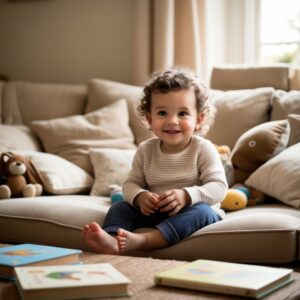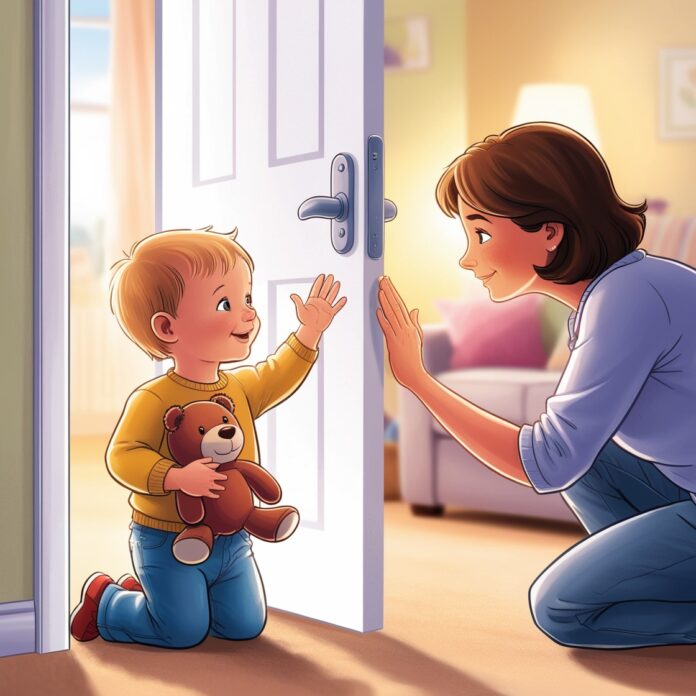Separation anxiety in toddlers is a common developmental phase, often occurring between 8 months and 3 years old. During this time, children experience heightened feelings of distress when separated from their parents or primary caregivers. This phase can be emotionally taxing for both the child and the parent, but it is an important part of the toddler’s growth and emotional development. Thankfully, there are several strategies that can help manage separation anxiety in toddlers without tears, creating a smoother transition for both parent and child.

What Causes Separation Anxiety in Toddlers?
Separation anxiety is rooted in a toddler’s developing sense of attachment and their increasing awareness of the world around them. At this stage, children are still learning how to regulate their emotions and understand the concept of time. Their deep attachment to their parents makes the prospect of separation feel overwhelming. Common causes of separation anxiety include:
-
Attachment development: Toddlers form strong emotional bonds with their caregivers.
-
Fear of the unknown: New environments, unfamiliar people, or sudden changes in routine can cause anxiety.
-
Developmental milestones: As toddlers gain independence, they may feel anxious about being separated from their safe zone—their caregivers.
Although separation anxiety is normal, parents can play an essential role in easing their child’s distress through gentle and thoughtful approaches.
Practical Tips to Manage Separation Anxiety in Toddlers Without Tears
1. Establish a Consistent Routine
Children thrive on consistency and routine. Having a predictable schedule helps toddlers feel safe and secure. Whether it’s a specific goodbye routine or regular drop-off rituals, consistency can reduce the anxiety around separation.

Tip: Create a short and reassuring goodbye ritual, such as a special handshake, a hug, or saying “I love you” each time you leave. This consistent routine can help build trust and reduce uncertainty.
2. Give Your Toddler a Sense of Control
While toddlers may not have control over many aspects of their environment, offering small choices can empower them and reduce feelings of helplessness. Allow your child to choose which toy to bring to daycare or whether to wear the red or blue shoes. This autonomy can give them a sense of confidence when faced with separation.
Tip: Giving them a choice about something related to the transition can reduce feelings of helplessness and anxiety. Even small decisions, like choosing a snack or which backpack to carry, can make a big difference.
3. Practice Short Separations First
If possible, start with brief separations to help your toddler get used to the idea of being away from you. Gradually increase the duration of the separations as they become more comfortable. This helps build trust that you will always return and that separations are temporary.
Tip: Start by leaving your child with a trusted friend or family member for short periods of time. Gradually lengthen these separations to build their confidence and reduce anxiety.
4. Keep Goodbyes Brief and Positive
Long, drawn-out goodbyes can heighten anxiety for both you and your child. Instead, aim for quick and positive farewells. Reassure them that you’ll be back, but don’t linger to avoid giving in to their emotional pleas.
Tip: Keep a calm and cheerful tone during your goodbye. Let your toddler know that you’ll be back soon and remind them of the fun activities ahead of them during the day.
5. Provide Comforting Objects
A comforting object, such as a favorite stuffed animal or blanket, can provide emotional support during times of separation. These familiar items can make your toddler feel more secure in your absence and help them manage anxiety.

Tip: Let your toddler choose a comforting item to bring along with them, whether it’s a special blanket, a toy, or a picture of you. This item can serve as a reminder of your love and presence.
6. Model Calmness and Confidence
Children often look to their caregivers for emotional cues. If you remain calm and confident when separating, your toddler is more likely to feel secure. Conversely, if you show signs of distress or hesitation, it can amplify their own anxiety.
Tip: Practice staying calm and reassuring, even if you feel anxious yourself. Children are very attuned to their caregivers’ emotions and will take comfort in seeing you model confidence.
7. Use Transitional Objects or Tools
Some parents find that transitional objects, such as a photo of the family or a small memento, can help ease anxiety. These tools act as reminders of the parent’s presence, even when they are not physically there.
Tip: Try leaving a note or photo in your child’s bag to give them a tangible reminder of your love and presence. This can be a powerful comfort when feelings of anxiety arise.
8. Talk About Separation Ahead of Time
Before dropping your toddler off at daycare or preschool, discuss the upcoming separation with them in a calm and positive way. Talking about what will happen next can reduce fear and uncertainty.
Tip: Use simple language to describe the separation, such as, “Mommy will drop you off at school, and then you’ll play with your friends until I come back to pick you up.”
Handling Tears and Reluctance
It’s normal for toddlers to cry during separation, especially during the initial phases of adjustment. However, understanding that tears are a natural part of the process can help you stay calm and patient. If your child cries, acknowledge their feelings but reassure them that it’s okay to be apart for a while.
Tip: If your child is upset, offer comfort in the moment but remain consistent with your routine. Over time, your toddler will learn that separation is temporary, and the distress will lessen.
Managing separation anxiety in toddlers without tears takes patience, consistency, and understanding. While this stage can be challenging, it’s an important part of your toddler’s emotional development. By creating predictable routines, offering comfort and reassurance, and modeling calmness, you can help ease your child’s anxiety and support their growth into confident, independent individuals.

Remember, separation anxiety is a phase, not a permanent condition. With the right strategies, you can help your toddler navigate this developmental milestone with greater ease and emotional resilience.



